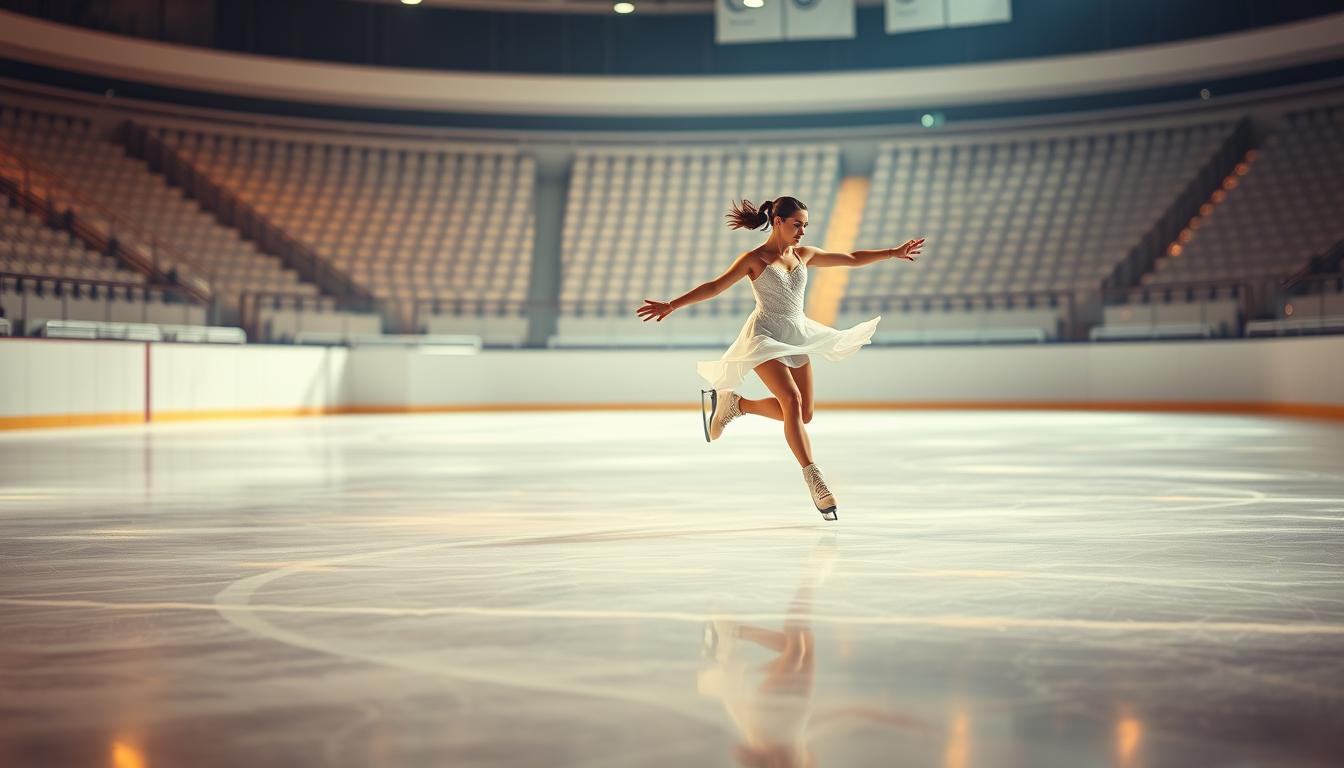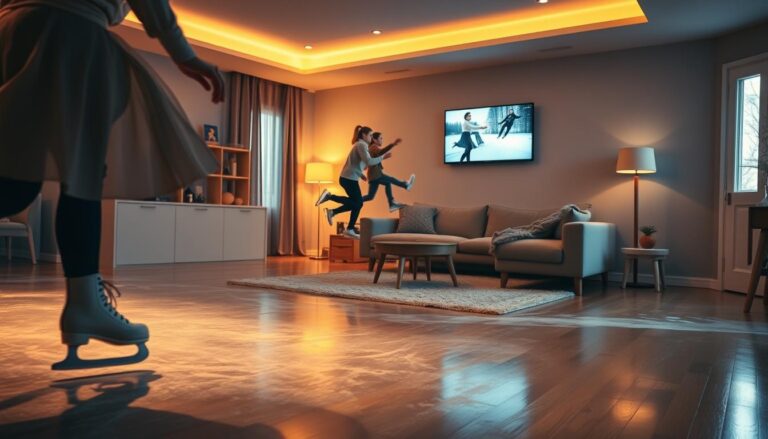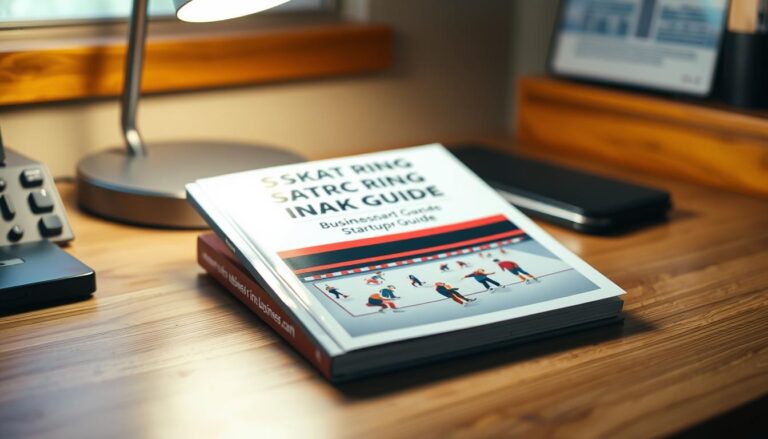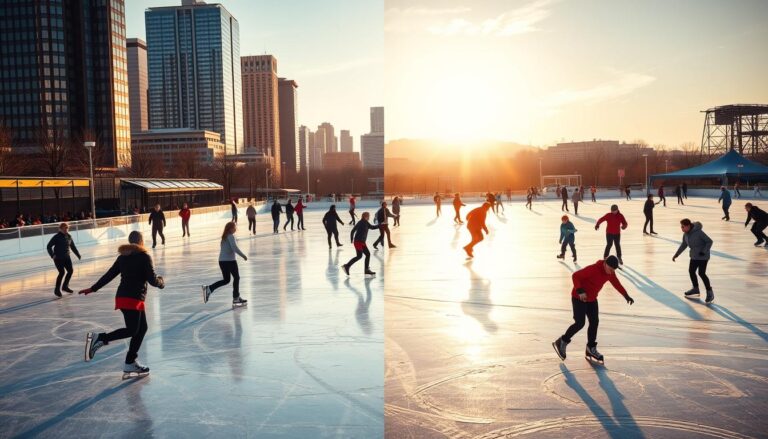Freestyle Skating: A Dynamic Discipline Within Roller Skating
Imagine a world where movement is art, and wheels are an extension of your body. Freestyle skating is a captivating discipline that mixes athletic skill with creative flair. It turns every surface into a personal stage for performance.
What is freestyle skating? It’s a roller skating style that combines technical skill, artistic movement, and personal flair. Unlike traditional skating, it demands a deep connection between the skater and their environment. It challenges participants to push their physical and creative limits.
Freestyle skating started from street performances and competitive dance. It has grown into a sophisticated sport loved by people of all ages. Skaters develop amazing body control, balance, and rhythmic precision through dance, gymnastics, and athletic skills.
This discipline needs dedication, creativity, and a grasp of complex movement patterns. Skaters learn to control their body weight, make precise turns, and create fluid sequences. It makes gravity seem like a suggestion. Whether for competitive performance or personal expression, freestyle skating offers a unique path to growth.
Different from traditional roller skating, freestyle skateboarding requires a technical approach. Skaters must master complex techniques, including footwork, dynamic spins, and seamless transitions. These skills transform ordinary movement into extraordinary performance art.
Your journey into freestyle skating starts with understanding its core principles. It’s not just about moving—it’s about moving with intention, style, and personal signature. The discipline welcomes those ready to challenge themselves, explore their limits, and create something remarkable on eight wheels.
Each skater brings a unique perspective to freestyle skating. Some focus on technical precision, while others emphasize artistic expression. The beauty of freestyle skating lies in its versatility and the personal story each performer brings to their performance.
As you explore this world, you’ll find a vibrant community of passionate skaters. They continue to push the limits of what’s possible on wheels. Freestyle skating is more than a sport—it’s a form of personal liberation, artistic expression, and continuous self-discovery.
What is Freestyle Skating: Understanding the Basics
Freestyle skating is a dynamic and artistic form of rollerblading. It turns traditional skating into a performance art. It combines technical skill, creative movement, and personal style into a unique athletic expression.
At its core, freestyle skating is more than just skating. Skaters use special techniques to create fluid, choreographed movements. These movements showcase their creativity and precision.
Core Elements of Freestyle Skating
The fundamental components of freestyle skating include:
- Advanced footwork techniques
- Intricate body movements
- Rhythmic transitions
- Artistic expression
Differences Between Freestyle and Regular Skating
Freestyle rollerblading is different from traditional skating in several ways:
- Complexity of movements
- Performance-oriented approach
- Higher skill requirements
- Emphasis on personal style
Essential Movement Patterns
Skaters develop specific movement patterns. These include spinning, gliding, jumping, and complex footwork. These patterns need a lot of practice, balance, and body control to do well.
Mastering freestyle skating takes dedication, creativity, and a passion for pushing physical boundaries. Whether you’re new or experienced, understanding these basics will help you appreciate the art of freestyle rollerblading.
The Evolution of Freestyle Skating Through the Decades
The history of freestyle skating is a story of creativity and innovation. It started as a street activity in the 1970s. Now, it’s a dynamic sport that excites skaters all over the world.
In the early years, freestyle skating came from urban street cultures. Cities like Los Angeles and New York were key. Skaters explored new ways to move, creating dance-like sequences and complex footwork.
- 1970s: Street skating culture develops
- 1980s: First organized freestyle skating competitions
- 1990s: Technical skills become more sophisticated
- 2000s: Global recognition and online communities expand
Technology was key in freestyle skating’s growth. New wheel designs, lighter materials, and better skate making allowed for more complex moves.
The history of freestyle skating shows a drive for new ideas. Skaters mixed dance, gymnastics, and art, turning skating into a respected art form.
By the early 2000s, freestyle skating was known worldwide. It had its own competitions and a growing community that celebrated it.
Essential Gear and Equipment for Freestyle Skaters
Freestyle skating needs special gear for safety and performance. The right gear makes skating better, letting you glide with confidence. It’s key for both new and experienced skaters.
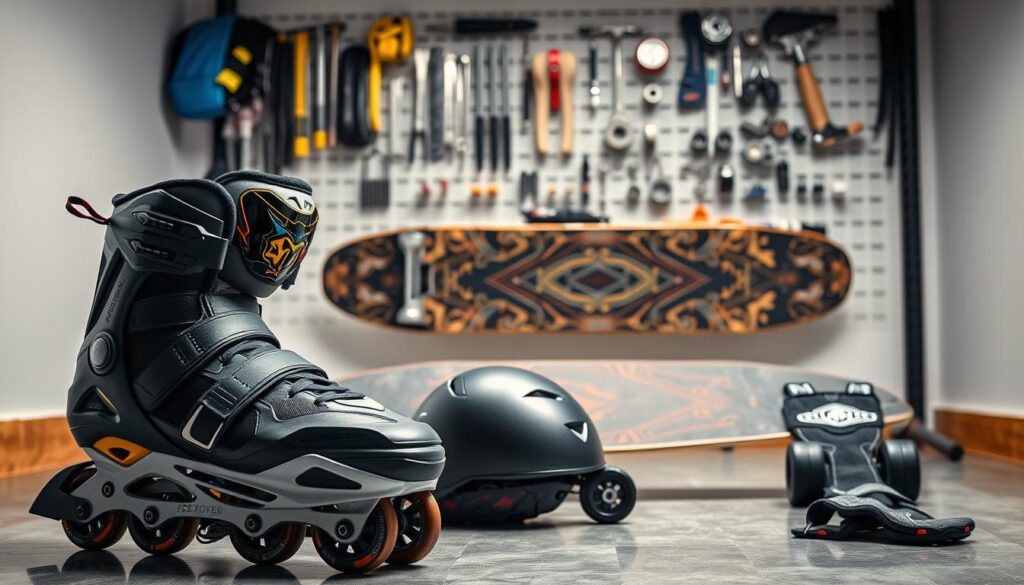
Choosing the right gear is important. It should fit your skill, style, and comfort.
Choosing the Right Skates
Start with the right skates. Look at these important points:
- Boot fit and ankle support
- Wheel hardness and diameter
- Bearing quality
- Plate material and flexibility
Experts say get boots that support your ankles well and move smoothly.
Protective Equipment Requirements
Safety is key in freestyle skating. You need:
- Helmet with impact protection
- Knee pads
- Elbow pads
- Wrist guards
| Protective Gear | Purpose | Recommended Material |
|---|---|---|
| Helmet | Head protection | Hard shell with EPS foam lining |
| Knee Pads | Joint protection | Reinforced plastic shell |
| Wrist Guards | Prevent fractures | Flexible plastic splint |
Maintenance and Care Tips
Good care keeps your gear in top shape. Regular maintenance stops unexpected failures and keeps performance high.
- Clean bearings after each skate
- Check wheel alignment monthly
- Replace worn parts quickly
- Store gear in cool, dry places
Spending time on maintenance saves money and improves your skating.
Fundamental Techniques in Freestyle Skating
Learning freestyle skating is all about mastering key techniques. These skills turn beginners into confident skaters. They lay the groundwork for more advanced moves and smooth skating.
When you start freestyle skating, knowing how to position your body is key. A good stance means:
- Keeping knees slightly bent
- Maintaining a low center of gravity
- Positioning feet shoulder-width apart
- Keeping upper body relaxed
How you distribute your weight is also vital. Skaters need to have precise control over their body. This lets them move smoothly between edges and stay balanced during tricky moves.
Key techniques for freestyle skating include:
- Edge control skills
- Weight transfer methods
- Precise foot placement
- Rhythm and flow management
Regular practice helps build muscle memory and confidence. Experts say to focus on basic moves before trying harder tricks.
Learning proper technique takes time, patience, and a desire to learn. By focusing on these core skills, you can build a strong foundation for your skating journey.
Mastering Basic Freestyle Skating Moves
Freestyle skating turns roller skating into a form of art. It’s all about movement and personal style. Whether you’re new or want to get better, learning basic tricks is key.
Getting good at freestyle tricks takes time, effort, and a plan. Knowing the basics and practicing helps a lot.
Forward and Backward Movements
Being able to move smoothly forward and backward is essential. It’s all about practice and keeping your body right.
- Master weight distribution on skates
- Practice smooth heel-to-toe transitions
- Develop consistent stride length
- Learn crossover techniques for fluid movement
Basic Spins and Turns
Doing spins and turns well is what makes freestyle skating special. You need strong core, balance, and control.
| Spin Type | Difficulty Level | Key Technique |
|---|---|---|
| Basic Pivot | Beginner | Single-foot rotation |
| Two-Foot Spin | Intermediate | Centered rotation |
| Backward Spin | Advanced | Reverse rotation control |
Balance and Control Exercises
Precision is the secret weapon of skilled freestyle skaters. Good balance makes your skating look like art.
- One-leg standing drills
- Edge control exercises
- Slow-motion movement practice
- Dynamic weight shifting techniques
Remember, freestyle tricks are all about your style and getting better. Every practice makes you better.
Advanced Freestyle Skating Tricks and Combinations
To move from basic to advanced freestyle skate tricks, you need hard work, skill, and smart practice. Skaters at the top level know that mastering advanced moves turns skating into a form of art. This art form wows the crowd.
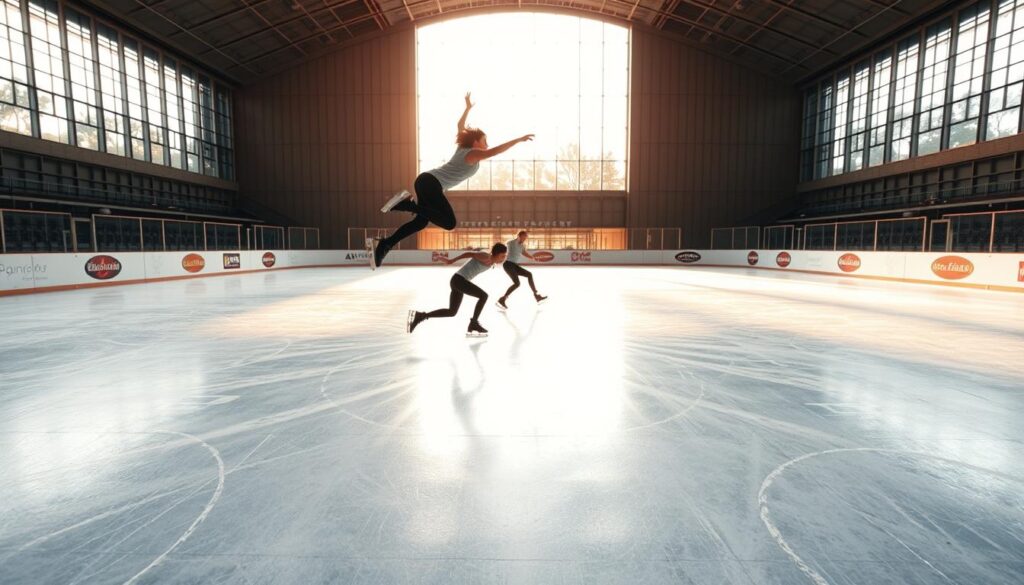
Getting better at freestyle skate tricks means trying harder tricks. These tricks need great body control, knowing where you are in space, and being creative with your moves.
- Advanced spinning combinations
- Multi-directional jumps
- Complex footwork sequences
- Dynamic transition movements
To get good at advanced tricks, work on your core strength, flexibility, and mental game. Each trick needs exact technique and lots of practice.
| Trick Difficulty Level | Skill Requirements | Practice Time |
|---|---|---|
| Beginner Advanced | Basic balance and control | 50-100 hours |
| Intermediate Advanced | Strong edge control | 100-250 hours |
| Professional Level | Exceptional body mechanics | 250-500 hours |
To create amazing freestyle skate tricks, plan your steps. Start with the basics, then add more complex moves. Always keep your technique right and stay safe.
Pro Tip: Video recording your practice sessions helps identify areas for improvement and track your progression.
Training and Practice Methods for Freestyle Skaters
Mastering freestyle skating takes dedication and a smart plan. It’s not just about skating. It’s about training wisely to build skills safely and steadily.
Creating a strong training plan helps you skate better faster. Here’s what makes a good practice routine.
Crafting Your Practice Routine
A good practice routine for freestyle skating should have:
- Drills for specific skills
- Regular practice times (30-60 minutes)
- Steps that get harder as you get better
- Time to work on your technique
Cross-Training Recommendations
Boost your freestyle skills with cross-training:
| Training Type | Benefits | Recommended Frequency |
|---|---|---|
| Strength Training | Strengthens core and legs | 2-3 times per week |
| Yoga | Boosts balance and flexibility | 1-2 times per week |
| Cardio Exercises | Increases endurance | 3-4 times per week |
Progress Tracking Techniques
Tracking your progress keeps you motivated. Try these methods:
- Record your practice with video
- Keep a checklist of skills
- Use performance metrics
- Set achievable goals
Remember, consistent practice and smart training are your keys to becoming an exceptional freestyle skater.
Safety Guidelines and Injury Prevention
Freestyle skateboarding is all about skill, creativity, and safety. It’s important to protect yourself while having fun. This means taking steps to avoid injuries and stay at your best.
Knowing the risks in freestyle skateboarding is key. This sport is full of challenges that need careful preparation and awareness.
- Always wear complete protective gear
- Check your equipment before skating
- Do proper warm-ups
- Learn how to fall safely
- Know your limits
Protective gear is vital for staying safe in freestyle skateboarding. Good gear can really lower the chance of serious injuries. Important items include:
| Protective Gear | Purpose |
|---|---|
| Helmet | Protects your head from impacts |
| Wrist Guards | Helps prevent wrist fractures during falls |
| Knee Pads | Protects your knees from scrapes and impacts |
| Elbow Pads | Prevents elbow injuries during slides |
Learning proper technique is also key to avoiding injuries. Freestyle skateboarding needs balance, control, and muscle memory. Practicing basic moves helps build strength and lowers accident risks.
Mental preparation is also vital. Stay focused, be aware of your surroundings, and slowly improve your skills. While it’s okay to try new things, do it safely to enjoy skating for a long time.
Famous Freestyle Skaters and Their Influence
The freestyle skate culture has been shaped by amazing individuals. They turned roller skating into a dynamic art form. These athletes have pushed limits, changed how we move, and inspired skaters all over the world.

The freestyle skating world is filled with incredible performers. They have left a lasting impact on the sport. Their new techniques and fearless spirit have made freestyle skating known worldwide.
Legendary Performers
Over the years, some skaters have become icons in freestyle skate culture. They created new techniques that changed how we see roller skating.
- Jack Boitani – Pioneer of urban freestyle skating
- Cesar Soto – Renowned for extraordinary street skating skills
- Naomi Grigg – International freestyle skating champion
Contemporary Stars
Today’s freestyle skating scene is full of amazing talent. Skaters show off incredible skills and creativity.
| Skater | Specialty | Notable Achievement |
|---|---|---|
| Chris Haffey | Urban Freestyle | X Games Gold Medalist |
| BamBam Banzai | Technical Freestyle | World Skating Championships Winner |
Rising Talents
The future of freestyle skating is bright. New skaters are bringing fresh ideas and techniques to the culture.
- Miguel Torres – Promising street style performer
- Rachel Kim – Emerging technical freestyle expert
- Diego Ramirez – Innovative urban skating prodigy
These skaters are more than just achievers. They show the spirit of creativity that makes freestyle skating’s culture so dynamic.
Freestyle Skating Competitions and Events
Freestyle skate competitions are the top showcase of skill, creativity, and passion in roller skating. These events challenge athletes to go beyond their limits. They turn skating into an art form.
Competitive freestyle skating has many levels, from local to international. Skaters show their skills with routines that mix technical skill with artistic flair.
- Local freestyle skate competitions provide entry-level opportunities for emerging talents
- Regional events offer more competitive platforms for skilled skaters
- National championships represent the pinnacle of competitive freestyle skating
- International tournaments attract world-class performers
Judges look at freestyle skate competitions with specific criteria. They consider:
- Technical difficulty of movements
- Artistic interpretation
- Musicality and rhythm
- Overall performance quality
Competitive freestyle skating needs a lot of training and prep. Successful competitors spend hours perfecting their technique, creating unique routines, and staying in shape.
For those wanting to compete, knowing the competition scene is key. Different events focus on different styles, from street to classical routines.
Freestyle Skating Communities and Culture
Freestyle skating is more than a sport; it’s a lively lifestyle that brings people together across the United States. It’s built on shared moments, support, and a strong sense of community. This goes beyond what you see in sports.
Today, skaters have new ways to connect, learn, and grow. The internet has changed how we interact, share tips, and make friends.
Online Communities: Digital Hubs of Freestyle Skating
The internet has changed freestyle skate culture, making strong online communities for all levels. These sites offer:
- Real-time technique tutorials
- Global skill-sharing forums
- Virtual training workshops
- Performance video exchanges
Local Skating Groups: Building Real-World Connections
Online spaces are important, but local groups are the heart of freestyle skating. They provide:
- Group practice sessions
- Skill development workshops
- Local competition opportunities
- Mentorship programs
Social Media’s Powerful Influence
Social media has a big role in freestyle skate culture. Instagram, TikTok, and YouTube let skaters show off their skills and inspire others.
| Platform | Primary Function | Community Impact |
|---|---|---|
| Visual skill sharing | Viral trick tutorials | |
| TikTok | Short-form performance videos | Trend creation |
| YouTube | Comprehensive tutorials | In-depth skill development |
The freestyle skate culture keeps growing, thanks to dedicated people. They turn skating into a powerful, connected community experience.
Music and Choreography in Freestyle Skating
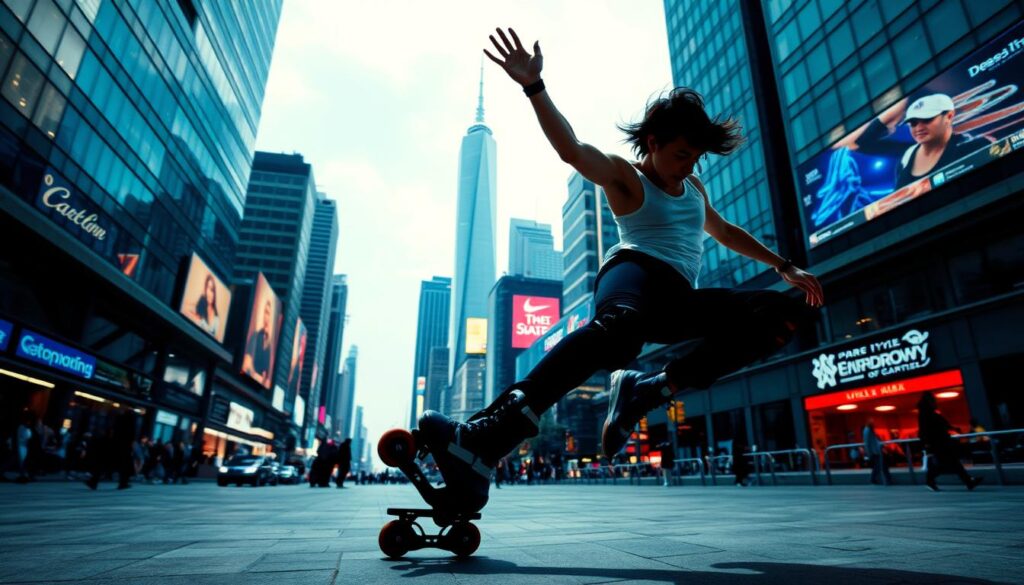
Freestyle rollerblading turns skating into an art form. Music brings it to life, linking rhythm and motion. Skaters express themselves through their unique style, making each routine a dance on wheels.
Choosing the right music is key for freestyle rollerblading. The track sets the mood and guides the skater’s moves. Different genres offer different creative paths:
- Hip-hop: Sharp, angular movements
- Classical: Fluid, graceful transitions
- Electronic: High-energy, dynamic sequences
- Jazz: Improvisational and syncopated steps
Choreography in freestyle rollerblading means understanding music. Skaters match their moves with the beat, tempo, and emotions. Body language becomes a visual instrument, turning sound into movement.
| Musical Genre | Skating Style | Emotional Expression |
|---|---|---|
| Hip-hop | Urban, aggressive | Confidence, power |
| Classical | Smooth, elegant | Grace, sophistication |
| Electronic | Dynamic, technical | Energy, precision |
Professional freestyle rollerbladers spend hours mastering their craft. They learn how to enhance musical stories through movement. This creates performances that wow both audiences and judges.
Common Mistakes to Avoid in Freestyle Skating
Learning freestyle skating is not easy. Every skater faces challenges that can slow them down. Knowing these common mistakes helps you skate better and safer.
Beginners often make basic errors that affect their performance and confidence. It’s key to recognize these mistakes to improve.
- Incorrect Weight Distribution: Skaters often put too much weight on their heels or toes, affecting balance and control
- Poor Posture: A stiff or hunched posture reduces flexibility and increases injury risk
- Neglecting Core Strength: Weak core muscles make advanced freestyle skating techniques hard
- Inadequate Practice Technique: Repeating moves without proper form reinforces bad skating habits
Mental barriers can also be tough when learning freestyle skating. Fear of falling or trying complex moves can hold skaters back. A growth mindset and consistent training can help overcome these barriers.
Professional freestyle skaters suggest breaking down complex moves into smaller steps. This helps build confidence and muscle memory while reducing injury risk.
- Start with basic techniques
- Practice consistently
- Seek professional guidance
- Use protective gear
- Film and analyze your skating
Every mistake is a chance to learn and get better. Patience, persistence, and a positive attitude are key to mastering freestyle skating.
The Future of Freestyle Skating
Freestyle skateboarding is on the verge of a big change. It’s mixing new tech with creative ideas. This will change how skaters do their tricks.
The world of freestyle skateboarding is about to change a lot. New tech and cultural shifts will bring big changes. Skaters will see new things they can do on their boards.
Emerging Trends in Freestyle Skating
- Digital training platforms with real-time performance tracking
- Augmented reality skating experiences
- Sustainable and eco-friendly skate equipment
- Increased integration of social media challenges and competitions
Technological Advancements
New tech is changing skateboarding. Smart skates with sensors will give skaters new insights. They can see how to improve their tricks better.
| Technology | Impact on Freestyle Skating |
|---|---|
| AI Performance Analysis | Personalized skill improvement recommendations |
| Advanced Materials | Lighter, more responsive skate designs |
| Wearable Tech | Real-time movement tracking and technique optimization |
Growth Predictions
More people will start freestyle skateboarding. Younger fans will join through digital platforms and new training methods. Urban communities and virtual skating networks will help grow the sport.
As tech meets sports, freestyle skateboarding will get even better. It will be more fun and exciting for everyone. The future of skating is looking very promising.
Conclusion
What is freestyle skating? It’s more than just rolling on wheels. It’s an electrifying art form that mixes athletic skill with creative flair. Our exploration into this dynamic discipline has shown us the amazing world waiting for skaters eager to explore new ways of moving.
You now have a full guide for your freestyle skating journey. You’ll learn more than just how to move. You’ll build confidence, join a lively community, and find a special path to personal growth and physical achievement.
Your freestyle skating adventure begins with passion, dedication, and a love for learning. Whether you’re into competitive skating or street-style, every session is a chance to challenge yourself and grow. Safety, practice, and a curious spirit will guide you on this thrilling path.
As you enter the world of freestyle skating, recall that every pro began where you are now. They were curious, eager, and ready to roll. Embrace the learning, connect with others, and always keep exploring the amazing possibilities of your creativity and wheels.
